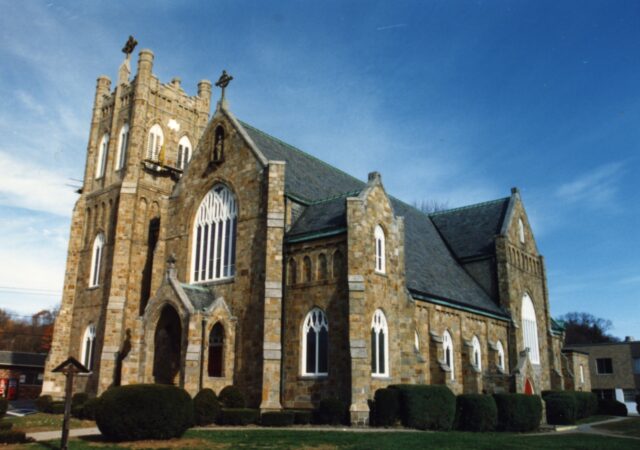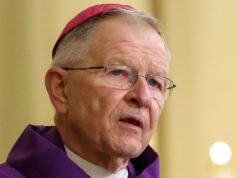
“Uh, we had something happen,” Father Joseph Crowley told the congregation March 5 near the end of Mass at St. Thomas Church in Thomaston, Connecticut, a parish once pastored by Knights of Columbus founder Blessed Michael McGivney.
Visibly rattled, he adjusted his collar and paused. “It’s hard to say, actually.”
“God provides, and it’s funny how God provides. Sometimes it comes in a weird way, in a mystical way, a strange way,” he continued, speaking to those at Mass and watching the parish’s livestream, now archived on YouTube. “One of our Eucharistic ministers was running out of hosts, and yet they didn’t. Suddenly there were more hosts in the ciborium. God duplicated himself in the ciborium.”
“It just happened today,” he said.
The alleged duplication of the Eucharist is now under investigation by the Holy See’s Dicastery for the Doctrine of the Faith as a potential Eucharistic miracle. If authenticated, it would join about 100 church-recognized Eucharistic miracles, including a miracle in rural Honduras approved in July by Bishop Walter Guillén Soto of Gracias. Four others have been recognized in the 21st century, according to the California-based Magis Center, which aims to connect faith and science.
While some recognized Eucharistic miracles involve circumstances like multiplication, others involve the Eucharistic host taking on characteristics of blood or flesh. Within the last 10 years, three such miracles — two in Poland and one in Mexico — have been recognized by bishops overseeing the dioceses where they occurred.
In 2006 in Tixtla, Mexico, a religious sister was distributing Communion at a retreat when a host she was holding appeared to begin to bleed. The host was given to a team of scientists to study, and their analysis reportedly found the reddish substance “corresponds to blood in which there are hemoglobin and DNA of human origin.”
Two years later, in Sokolka, Poland, a consecrated host the priest dropped during Communion was placed in water to dissolve, according to standard practice, and it was locked in a safe in the sacristy. A week later, the sacristan, a religious sister, checked on the host, which she discovered to have a red stain on it. The host was removed from the water and as it dried, the stain ultimately appeared to look more like a wound. It was studied and found to include myocardial, or heart, tissue that was inexplicably interwoven with the bread fibers.
A similar alleged miracle took place five years later across Poland in Legnica, on Christmas Day 2013. A consecrated host that dropped on the floor was placed in water, where it formed red stains, as if the Eucharist was bleeding. Several research institutions examined the host, with the Department of Forensic Medicine in Szczecin stating the specimen contained “cross-striated muscle,” most similar to heart tissue that had undergone significant stress. Bishop Zbigniew Kiernikowski of Legnica approved the miracle for veneration in 2016.
In July, Honduran Bishop Soto confirmed an alleged miracle that occurred in a small rural parish with no resident priest. In June 2022, an extraordinary minister of holy Communion opened the parish’s tabernacle to remove the wooden ciborium containing the Eucharist and discovered dark stains on the corporal, a liturgical linen, wrapped around it.
The cloth was studied in October 2022 by a toxicology center in Tegucigalpa, and according to the news agency ACI Prensa, tests ruled out wood resin, animal blood or pigment, and it was also found to be free of mold, fungus or contamination. Instead, the stain was determined to be human blood of AB blood type with a positive Rh factor. According to ACI Prensa, “the scientific evidence and the notarized oaths of the witnesses were collected and sent to the Vatican for further investigation” at the request of apostolic nuncio in Honduras, Archbishop Gábor Pintér.

“God loves the marginal, the hidden, the simple. In an obscure village, without any social relevance, far from the urban area, the Lord chooses to manifest himself,” Bishop Soto told ACI Prensa.
Eucharistic miracle experts also frequently point to two other alleged miracles — one in Buenos Aires in 1996, where a desecrated host left in water in the tabernacle to decompose reportedly turned to bloody tissue, and the much older miracle at Lanciano, Italy, which occurred in the eighth century, where during Mass the consecrated body and blood of Christ became visibly flesh and blood. Both miracles have undergone scientific analysis, with results reportedly indicating the substance included human heart tissue.
Notably, Cardinal Jorge Bergoglio, the future Pope Francis, as archbishop of Buenos Aires initiated the investigation of the 1996 miracle, and reportedly said of it, “The Lord passed and left his mark.”
Eucharistic miracles, especially those that have been scientifically studied, may inspire or bolster faith in people who need “a little bit of empirical verification” for the Real Presence, said Jesuit Father Robert Spitzer, president of the Magis Center, which includes information about Eucharistic miracles among popular topics on its website.
Father Spitzer said that “good lab tests” on alleged Eucharistic miracles can help “convince a skeptical generation that’s scientifically clued-in” — particularly young people — that the Eucharist is truly Jesus’ body and blood. He said that kind of evidence is available in the lab reports from the miracles at Buenos Aires, Tixtla and Sokolka.
“If you put together all the scientific data from those reports … it really forms a strong preponderance of evidence for authenticity — that human heart tissue from the region of the upper left ventricle, which pumps blood to the rest of the body, is growing out of the substance of the host, integrated with the consecrated host on the level of the thin filaments of the myofibrils, a few microns of separation,” he told OSV News. “This is unbelievable. This is naturalistically, scientifically inexplicable.”
Dr. Scott French, an emergency medicine physician, is on the Magis Center’s board of advisers and presents on the science behind the recognized 21st-century Eucharistic miracles. He said those miracles show heart tissue and the presence of white blood cells, which do not ordinarily live outside of the body beyond 30 minutes. Additionally, all scientifically studied Eucharistic miracles indicate the presence of the rare AB blood group, the same blood group found on the Shroud of Turin, he said.
Part of French’s motivation is a 2019 Pew Research Center survey that found 69% of Catholics don’t believe in the Real Presence. “That’s why there’s all these Eucharistic miracles: God is shouting it to us. And so that’s it: People need to hear it … particularly our youth,” he said. “That’s our future.”
In some cases, scientific queries have shown that visible changes to a consecrated host are natural. In 2011 in the Archdiocese of St. Paul and Minneapolis and in 2015 in the Diocese of Salt Lake City, biological analyses of consecrated hosts with red staining determined the cause to be fungus, which some skeptics say could be the cause of other alleged Eucharistic miracles.
Michael O’Neill — known as “The Miracle Hunter,” with a show by the same name on EWTN — said that when an alleged miracle occurs, the diocesan bishop may choose whether to investigate it, and following an investigation, whether to approve the event as a miracle worthy of belief.
“In a lot of cases, miracles are complicated, in that they leave room for faith, where we must put in some faith to really believe a miracle is happening,” he told OSV News. “But when it comes to miracles that are the most scientifically testable, or provable, Eucharistic miracles are remarkable and unique, because we can see a true miracle really happening, as provable by science.”
O’Neill is in the midst of a documentary project with interviews of experts and scientists who have studied the miracles at Lanciano, Buenos Aires, Tixtla, Sokolka and Legnica. He said the project has special relevance for the National Eucharistic Revival, an initiative of the U.S. bishops underway to inspire greater understanding of and reverence for the Real Presence.
The documentary — and O’Neill’s accompanying book — are expected to be available ahead of the 2024 National Eucharistic Congress, the pinnacle of the three-year revival.
While Eucharistic miracles have been getting more attention through the revival, including through the International Eucharistic Miracles of the World exhibit, a traveling exhibit of Eucharistic miracles initially cataloged online by Blessed Carlo Acutis, they fall under the category of private revelation, and Catholics are not required to believe in them, O’Neill said.
He emphasized that the most important miracle is the miracle of transubstantiation that occurs at every Mass — the bread and wine becoming Jesus Christ in his body and blood, soul and divinity.
“That is the true miracle and that’s what Catholics are to believe — that’s a dogma of our faith,” O’Neill said. “When it comes to Eucharistic miracles, we might say it’s a miracle on top of a miracle. It’s just a little bit of a bonus that God gives us, perhaps, to help our faith, because it is the hardest of all Catholic beliefs — that God, in all his power and might, would humble himself and make himself present to us in something that can be eaten.”
However, Stacy Trasancos, a Catholic with a doctorate in chemistry, cautions people from basing their faith solely in these miracles. In the 2021 book “Behold It is I: Scripture, Tradition, and Science on the Real Presence” that Trasancos co-wrote with Father George Elliott of the Diocese of Tyler, Texas, she examined the lab reports from analyses of the miracles at Lanciano and Buenos Aires, and she said their results were less conclusive than reported.
“We’re Catholics and we’re after the truth,” Trasancos told OSV News. “We don’t have to make exaggerations. We don’t have to be ambiguous about the scientific data. We don’t have to be afraid of what the science might reveal.”
She said some oft-repeated narratives about some Eucharistic miracles also aren’t accurate, such as a claim that a scientific commission appointed in 1973 by the World Health Organization conducted 500 tests on the Lanciano miracle and remained baffled by their results. The claim has been debunked by Dr. Franco Serafini, author of the 2021 book “A Cardiologist Examines Jesus: The Stunning Science Behind Eucharistic Miracles,” who reviewed the supposed WHO report to discover it was actually data from tests of Egyptian mummies placed between two pages about the Lanciano miracle. Its origin is unknown.
If the church wants to promote the scientific basis for accepting Eucharistic miracles, Trasancos advises the miracles be restudied with the same rigorous standards of proof and that scientists devise a standard set of procedures for the study of future reported miracles. If the results show that there are natural, not supernatural, explanations for the alleged miracles, she said, it should not shake anyone’s faith.
“We don’t really need these miracles to be true in order for us to believe in the Real Presence,” she said. “Our faith in the real presence ought to be primarily based on our faith in Jesus Christ.”
Despite the weaknesses of individual tests, Father Spitzer said that the evidence, taken as a whole, “seems to suggest that now we’re crossing a threshold where it’s not unreasonable, it’s not pure enthusiasm, to believe that there really is living heart tissue growing out of these consecrated hosts.”
“It’s not ‘proof,” he said. “All we’re saying is there’s scientifically investigated evidence that supports probabilistic evidence — that is to say, it supports a reasonable and responsible belief.”
The Dialog provides readers news to your inbox with the Angelus e-newsletter. Sign up here for a free subscription to the Angelus.







